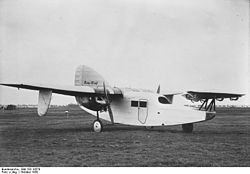Focke-Wulf F 19
| Focke-Wulf F 19 | |
|---|---|

|
|
| Type: | Test aircraft |
| Design country: | |
| Manufacturer: | |
| First flight: |
September 2, 1927 |
| Commissioning: |
never put into service |
| Production time: |
1926/1927 |
| Number of pieces: |
2 |
The Focke-Wulf F 19 “ Ente ” was a test aircraft made by the German manufacturer Focke-Wulf in the second half of the 1920s. The F 19 was to serve as a test vehicle for the canard construction, which was to be used in a new transport aircraft to be developed.
history
Henrich Focke and his brother Wilhelm had been working on duck-type flight models since 1908 and had also received a patent in this area. In 1909, a full-scale aircraft equipped with a 40-hp engine was built in the Rumpler works. However, with the project financier and lawyer Alberti at the wheel, only a few short flights could be carried out in a field near Berlin.
It was not until 1925 that the German Research Institute for Aviation (DVL) took up Focke's developments again and placed the order for the construction of a canard aircraft with which the practical usability of this design was to be demonstrated. The wind tunnel built in 1908 at the Göttingen Model Research Institute could also be used for the project studies .
The first machine was completed in 1927 and flew for the first time on September 2nd of the same year. 14 successful test flights were carried out before the machine crashed on September 29, 1927, in which Georg Wulf was killed.
The second machine built with the aircraft registration D-1960 was designated as F 19a and flew for the first time in late 1930. The following year it was shown on a promotional tour in several European countries. An Allied air raid in 1944 destroyed the D-1960 exhibited in the German Aviation Collection in Berlin .
construction
The main reason for the choice of Canardbauweise was next to the rollover safety during landing, even at full brake application, particularly the enrobing safety of this structural design. Another aspect was the greater protection of the passengers in the event of an accident, since they were accommodated further away from the tip of the aircraft than with a conventional transport aircraft.
The fuselage construction was made up of welded steel tubes covered with fabric. The wooden wings were also covered with fabric. The leading edge of the wing, which was moved far back, was only 3.60 m away from the rear end. The front wing had an almost triangular plan, with the base of the triangle pointing forward. In the first machine (F 19), this wing could be moved up or down from the cockpit like a rocker in order to better compensate for the asymmetrical thrust in the event of an engine failure. This construction was seen as the cause of the accident with the first machine and was changed accordingly in the F 19a by firmly bracing the front wing with a cable.
Due to the short lever arm for steering around the vertical axis, the vertical stabilizer had to be designed to be exceptionally large. In addition, two further rudder surfaces were provided under the main wings on the left and right.
The two engines had pull propellers, which were to be replaced by pusher propellers in a later series version . The control surfaces of the machine should thus remain unaffected by the turbulence of the propeller jet. The fuel tanks were located in the wing nose, left and right of the fuselage.
The three-passenger cabin started right at the leading edge of the main wings. Access was through a door on the right. The pilot sat in an open cockpit.
Technical specifications
| Parameter | F 19a |
|---|---|
| crew | 1 |
| Passengers | 3 |
| length | 10.53 m |
| span | 10.00 m (main wing) 5.00 m (canard wing) |
| Wing area | 29.5 m² (main wing) 6.00 m² (canard wing) |
| payload | 475 kg |
| Empty mass | 1175 kg |
| Max. Takeoff mass | 1650 kg |
| Cruising speed | 128 km / h |
| Top speed | 142 km / h |
| Engines | 2 × Siemens & Halske Sh 14 with 110 PS (81 kW) each 2 × Siemens & Halske Sh 11 with 80 PS (59 kW) each for the F 19 |
See also
literature
- Rex King: The ugly duckling , in Airplane Monthly, October 1973, pp. 275-278
Web links
- Günter Frost: Focke-Wulf F19 "Duck". Retrieved on November 11, 2018 (contribution by the German Aviation History Working Group).
- Edwin Heinze: The Focke-Wulf Ente , available online in FLIGHT International, January 2, 1931 (English, accessed February 2, 2012)
- Flight recordings on youtube.com (accessed February 2, 2012)
Individual evidence
- ↑ According to the company tradition of that time, all Focke-Wulf aircraft had internal bird names.
- ↑ Lawyer Dr. Alberti as a test pilot ( page no longer available , search in web archives ) Info: The link was automatically marked as defective. Please check the link according to the instructions and then remove this notice.
- ↑ Information on the wind tunnel in Göttingen
- ^ Rex King, Airplane Monthly 10/1973, p. 278

